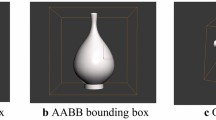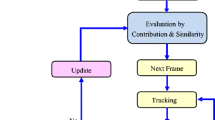Abstract
Aiming at the problem of collision detection and collision point information evaluation in the process of human-robot collaboration, the binocular camera is used as an external sensor to observe. Collision detection is realized by tracking the motion of human-robot through the color information of joints. Firstly, the Camshift algorithm is used to track the position of the manipulator joints and the human arm joints based on the color information. In order to solve the factors that may cause target loss during tracking process, such as shelter and background color similar problems, Kalman filter is integrated on the basis of Camshift algorithm. A similarity threshold is set to judge whether there is interference in the tracking process. The tracking experiment proved that the Kalman filter is effective and enhances the robustness of the tracking algorithm. Secondly, a bounding box collision detection method based on space domain is designed. The sphere bounding box and the cylindrical bounding box is used as the human-robot bounding boxes. The equations of the distance between different boxes are derived and the position of the collision point on the manipulator is calculated. Finally, an experimental environment is built for verification. The distance error of the collision is within 0–10 mm, and the position error between the calculated collision point and the pre-determined collision point is within 10%.
Similar content being viewed by others
References
A.-N. Sharkawy and N. Aspragathos, “Human-robot collision detection based on neural networks,” International Journal of Mechanical Engineering and Robotics Research, vol. 7, no. 2, pp. 150–157, 2018.
F. Min, G. Wang, and N. Liu, “Collision detection and identification on robot manipulators based on vibration analysis,” Sensors, vol. 19, no. 5, p. 1080, 2019.
S. Haddadin, A. De Luca, and A. Albu-Schäffer, “Robot collisions: A survey on detection, isolation, and identification,” IEEE Transactions on Robotics, vol. 33, no. 6, pp. 1292–1312, 2017.
M. Zhiju and W. Haibin, “Sensorless collision detection for robot manipulator,” Journal of Test and Measurement Technology, vol. 27, no. 3, pp. 254–259, 2013.
Z. Hanjie, Collision Detection of Robotic Manipulators, Harbin Insititute of Technology, 2017.
A. Cirillo, P. Cirillo, G. De Maria, C. Natale, and S. Pirozzi, “A proximity/contact-force sensor for human safety in industrial robot environment,” Proc. of IEEE/ASME International Conference on Advanced Intelligent Mechatronics, pp. 1272–1277, 2013.
A. de Luca and F. Flacco, “Integrated control for pHRI: Collision avoidance, detection, reaction and collaboration,” Proc. of 4th IEEE RAS & EMBS International Conference on Biomedical Robotics and Biomechatronics (BioRob), pp. 288–295, 2012.
T. Ren, Y. Dong, D. Wu, and K. Chen, “Collision detection and identification for robot manipulators based on extended state observer,” Control Engineering Practice, vol. 79, pp. 144–153, 2018.
Z. Wang, L. Liu, W. Yan, J. He, B. Cui, and Z. Li, “Research on collision point identification based on six-axis force/torque sensor,” Journal of Sensors, vol. 2020, p. 8881263, 2020.
J. O’Neill, J. Lu, R. Dockter, and T. Kowalewski, “Practical, stretchable smart skin sensors for contact-aware robots in safe and collaborative interactions,” Proc. of IEEE International Conference on Robotics and Automation (ICRA), pp. 624–629, 2015.
Y. Xu, F. Jiang, S. Newbern, A. Huang, C.-M. Ho, and Y.-C. Tai, “Flexible shear-stress sensor skin and its application to unmanned aerial vehicles,” Sensors and Actuators A: Physical, vol. 105, no. 3, pp. 321–329, 2003.
T. Someya, T. Sekitani, S. Iba, Y. Kato, H. Kawaguchi, and T. Sakurai, “A large-area, flexible pressure sensor matrix with organic field-effect transistors for artificial skin applications,” Proceedings of the National Academy of Sciences, vol. 101, no. 27, pp. 9966–9970, 2004.
Z. Xiuli and H. Chunyan, “Design and collision experiment of tactile sensing device for collaborative robot,” School of Mechanical, Electronic and Control Engineering, Beijing Jiaotong University, vol. 43, no. 4, p. 88, 2019.
A. De Luca, A. Albu-Schaffer, S. Haddadin, and G. Hirzinger, “Collision detection and safe reaction with the DLR-III lightweight manipulator arm,” Proc. of IEEE/RSJ International Conference on Intelligent Robots and Systems, pp. 1623–1630, 2006.
F. Flacco, T. Kröger, A. de Luca, and O. Khatib, “A depth space approach to human-robot collision avoidance,” Proc. of IEEE International Conference on Robotics and Automation, pp. 338–345, 2012.
J. Pan, S. Chitta, and D. Manocha, “FCL: A general purpose library for collision and proximity queries,” Proc. of IEEE International Conference on Robotics and Automation, pp. 3859–3866, 2012.
D. M. Ebert and D. D. Henrich, “Safe human-robot-cooperation: Image-based collision detection for industrial robots,” Proc. of IEEE/RSJ International Conference on Intelligent Robots and Systems, vol. 2, pp. 1826–1831, 2002.
D. Exner, E. Bruns, D. Kurz, A. Grundhöfer, and O. Bimber, “Fast and robust CAMShift tracking,” Proc. of IEEE Computer Society Conference on Computer Vision and Pattern Recognition-Workshops, pp. 9–16, 2010.
W. Guan, Z. Liu, S. Wen, H. Xie, and X. Zhang, “Visible light dynamic positioning method using improved Camshift-Kalman algorithm,” IEEE Photonics Journal, vol. 11, no. 6, pp. 1–22, 2019.
A. H. Mazinan and A. Amir-Latifi, “Applying mean shift, motion information and Kalman filtering approaches to object tracking,” ISA Transactions, vol. 51, no. 3, pp. 485–497, 2012.
S.-K. Weng, C.-M. Kuo, and S.-K. Tu, “Video object tracking using adaptive Kalman filter,” Journal of Visual Communication and Image Representation, vol. 17, no. 6, pp. 1190–1208, 2006.
C. Ericson, Real-time Collision Detection, CRC Press, 2004.
T. Urano, T. Matsui, T. Nakata, and H. Mizoguchi, “Human pose recognition by memory-based hierarchical feature matching,” Proc. of IEEE International Conference on Systems, Man and Cybernetics (IEEE Cat. No. 04CH37583), vol. 7, pp. 6412–6416, 2004.
Author information
Authors and Affiliations
Corresponding author
Additional information
Publisher’s Note
Springer Nature remains neutral with regard to jurisdictional claims in published maps and institutional affiliations.
Shuangning Lu received his B.E. degree in software engineering from Chengdu University of Information Technology in 2018. His research interests include collaborative robot and collision detection.
Zhouda Xu received his M.Eng. degree in control science and engineering from China Jiliang University in 2020. His research intrests include collaborative robot and wire and cable detection.
Binrui Wang received his Ph.D. degree in pattern recognition and intelligent system from the School of Information Science and Engineering at Northeastern University in 2005. Currently, he is a professor in the College of Mechanical and Electrical Engineering at China Jiliang University, China. His research interests include intelligent control algorithm and humanoid robot.
Rights and permissions
About this article
Cite this article
Lu, S., Xu, Z. & Wang, B. Human-robot Collision Detection Based on the Improved Camshift Algorithm and Bounding Box. Int. J. Control Autom. Syst. 20, 3347–3360 (2022). https://doi.org/10.1007/s12555-021-0280-0
Received:
Revised:
Accepted:
Published:
Issue Date:
DOI: https://doi.org/10.1007/s12555-021-0280-0




